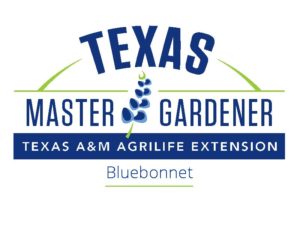
Board Meeting: 8:30 a.m – 10:00 a.m.
Social: 10:00 a.m. – 10:30 a.m.
Program: 10:30 a.m.– 12:00 noon
Presentation: Wizzie Brown – Entomology (Via Zoom)
Texas A&M Senior Extension Program Specialist – IPM
Article and photos submitted by Teresa Wilson.
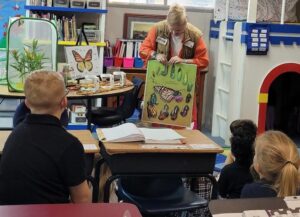
Nancy Galloway explaining the butterfly life cycle.
Students at Citadel Christian School in Brenham, Texas had the opportunity to learn about Monarch butterflies through two educational programs lead by Bluebonnet Master Gardener Assocation member Nancy Galloway, with assistance from Teresa Wilson and Mandy Ames, also Master Gardeners. Both programs were held at the school on Novebmer 6, 2023.
The first program was for students in grades 1 through 4. It featured a detailed display illustrating theMonarch butterfly’s life cycle, from egg to butterfly, along with a live butterfly exhibit. Nancy, clad in signature Monarch orange top with a light brown field vest mimicing the colors of the Monarch, covered aspects of the north and south Monarch migrations, explaining the life cycle and yearly generational patterns.
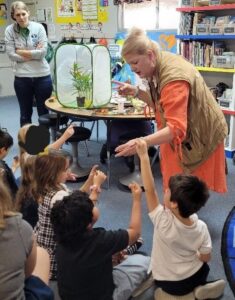
Nancy Galloway leading class with Mandy Ames looking on.
Students were also given the chance to practice tagging Monarchs for research purposes, using simulated butterflies. In a practical demonstration, Nancy tagged a Monarch she caught earlier that day in her garden, with hopes that it would be found in Mexico, contributing to migration data.
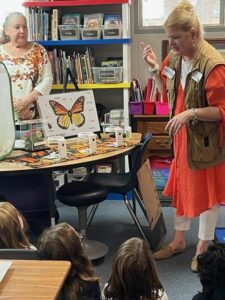
Nancy Galloway talking with the class; Teresa Wilson looking on.
The second presentation was tailored for 10th-grade students who already had some knowledge of Monarchs. Nancy delved into the habits, nutrition, nesting needs, pests, and diseases associated with Monarchs. The class is now planning to create a natural area with milkweed, following Nancy’s recommendations, to establish a Monarch waystation habitat.
Nancy Galloway’s adeptness in adjusting lecture levels to suit the audience made the presentations informative. Teachers at the school also received educational packets to support ongoing learning.
This presentation was part of the Bluebonnet Master Gardener Association’s work to provide garden-related education at the school.
Board Meeting:  8:30 a.m.
8:30 a.m.
General Meeting: 10:30 a.m.
Presentation: Joseph (Joe) & Suzanne Hakkinen. Joe is President of the Bastrop County’s Beekeepers Association. His presentation will highlight how to start and raise bees, the diseases that affect bees and also what plants are suitable for bees. He will most likely bring an enclosed bee container, where the queen is keeping all of the workers busy. For more information about the Texas Beekeepers Association, check out there website: https://texasbeekeepers.org/
This meeting will also feature a pot-luck lunch after the presentation. Please bring a favorite dish or dessert to share with your fellow gardeners.
February 21: Garden Stretches: Stop the Ache before you Rake (Michelle Wright, Austin County, CEA)
March 21: Composting (Mary Karish, Waller County Master Gardener)
April 18: TBA
May 16: Orchids
June – August: No Program
September 19: Plumerias (Faye Beery, Bluebonnet Master Gardener)
October 17: Wonderful World of the Honeybee (Tom Shaughnessy, Local Beekeeper)
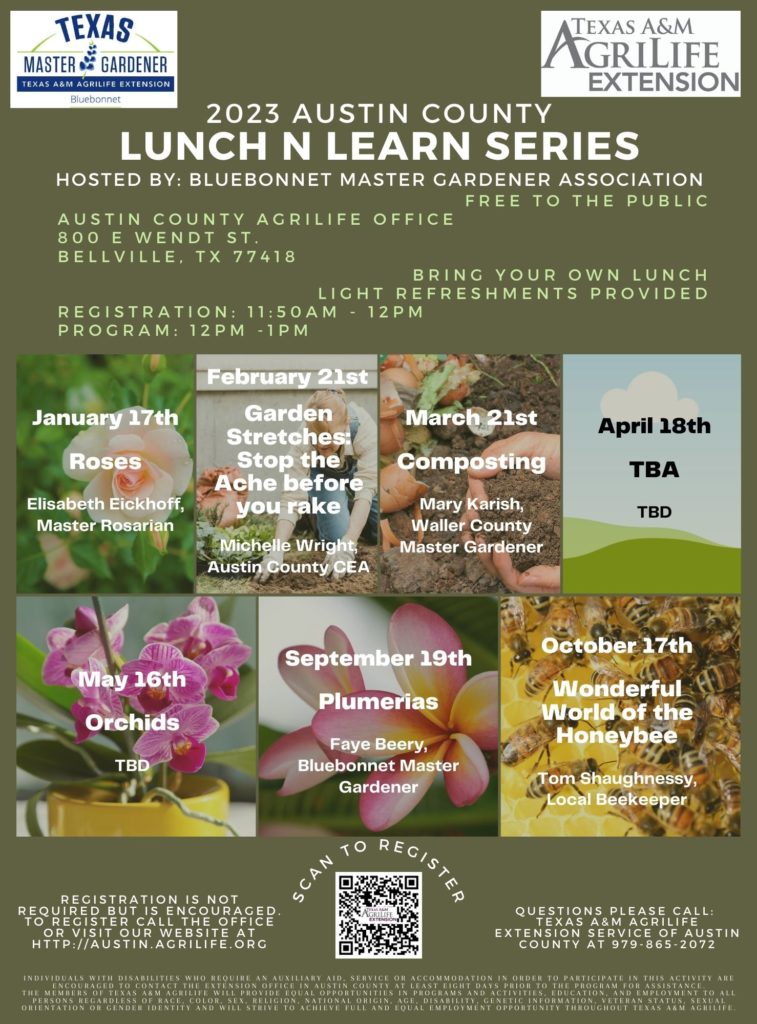
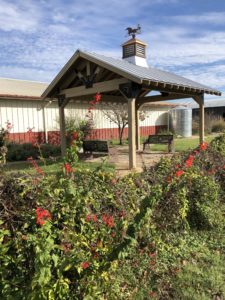 There’s always something blooming in our native plants garden. Low maintenance and lots of color even in the fall. Texas Lantana, Scarlet Sage, Green-Eyed Daisies, Mealy Blue Sage and Esperanza are still showing off their beautiful flowers. The Chile Pequins are full of peppers and the Yaupon Holly is loaded with beautiful red berries. The garden is open to the public so stop by and see what’s blooming.
There’s always something blooming in our native plants garden. Low maintenance and lots of color even in the fall. Texas Lantana, Scarlet Sage, Green-Eyed Daisies, Mealy Blue Sage and Esperanza are still showing off their beautiful flowers. The Chile Pequins are full of peppers and the Yaupon Holly is loaded with beautiful red berries. The garden is open to the public so stop by and see what’s blooming.
This Bluebonnet Master Gardener Association Texas Natives Garden is designed to educate visitors, students and area residents as to the benefits of native plants. The garden shows how native plants, trees and grasses attract bees, butterflies, and birds as well as providing a beautiful display of seasonal color. Water-wise gardening practices are on display as an educational tool to show how rainwater harvesting and a drip irrigation system can be used efficiently.
Link to more information about Lantana urliocides
Find the garden located at:
E.A. Arnim Archives & Museum
101 E. North Main Street
Flatonia, TX 78941
The garden is between the brick and metal buildings on Hwy 95.
Pete & Paula’s Pollinator Patch is a section of the Bluebonnet Master Gardener’s Sens Center Demonstration Garden in Austin County, Texas. The garden overall is dedicated to demonstrating sound techniques for growing vegetable and other food crops. However, this year, Master Gardeners Pete Smith and Paula Trahan started the “Pete & Paula’s Pollinator Patch” to demonstrate the use of plants which attract pollinators to the garden to pollinate the vegetables in the garden. As many fruit and vegetable plants require a pollinator to set fruit, attracting pollinators to the garden is necessary.
After about four months, Pete and Paula are pleased with how quickly our pollinator garden has progressed. “We truly got a late start, but everything has grown by leaps and bounds. Every plant was a pass along or freebie from the garden center.” Ms. Trahan explained. Pete & Paul’s next step is to include a small solar water feature in the center to attract more butterflies, bees and birds. Included in the garden are lantana, standing cypress, Asian purple basil, echinacea, porterweed, rock rose mallow.
By Faye Beery, Bluebonnet Master Gardener Assocaiton
That is how long the Master Gardener program has been going in our 4 county region. On May 25, 2021 the Bluebonnet Master Gardeners celebrated our 20th anniversary of the demonstration garden in Austin County. While the weather was not the best, everyone enjoyed the program given by Dr. Shackelford, good food and seeing the Bluebonnet Master Gardener Association’s demonstration garden located at the Sens Acitvity Center in Bellville, Texas. Vegetables were available, most gave a voluntary donation to the garden, as well as some produce was avaialbe to pick in the garden.
A big attraction in the garden was the keyhole garden. The keyhole concept was first introduced into arid African regions by the U.K. organization Send a Cow. The idea was to help poor families grow their own food despite the poor soil and drought conditions. The keyhole concept is a raised circular bed with a wedge shaped cutout on one side which allows persons easy access to the whole bed. When seen from above, it resembles a lock and keyhole. In the center is a wire cage for compost which decomposes and provides nutrients to the bed. This form is less labor intensive and more affordable for people who want to grow their own food. And you don’t have to bend over.
The outer structure can be any sturdy material, cinder blocks, bricks, rocks are a good choice. They are placed in a round design with a wedge on one side so that individuals can reach the middle as well as the outsides allowing for easy planting and harvesting. The wire cage in the center makes it easily accessible to place the compost materials.
A strong advocate of the keyhole concept is Deb Tolman, PhD, from Clifton, Texas. She is an environmental scientist and landscape designer and co-founder of the Silo Project a non-profit organization, which is centered on sustainability. Due to her outreach and workshops, there are more than 70 keyhole gardens in Clifton, which is in arid North Texas. She recommends a 3:1 ratio of brown and green material which forms the core garden. Decomposition rapidly generates heat and breaks down the material to feed plants. Brown material includes brown grass/leaves; paper and wood, straw, sawdust, lint from the dryer or vacuum, and lots of cardboard, which is the first layer in the bottom of the bed. It should be thoroughly wet to begin decomposition. Green materials include kitchen scraps, manure, green grass/leaves, or plants. Her website provides instructions on how to construct a keyhole garden. Follow the link to her Field Guide PDF .
There is also a new addition to the garden which is currently under construction this week. It is Pete and Paula’s pollinator patch. They plan to include plants which attract pollinators to the garden to pollinate the vegetables that grow there. We’ll have more on this when they begin planting.
I know everyone is happy to get back to our regular meetings. See you at the next one!
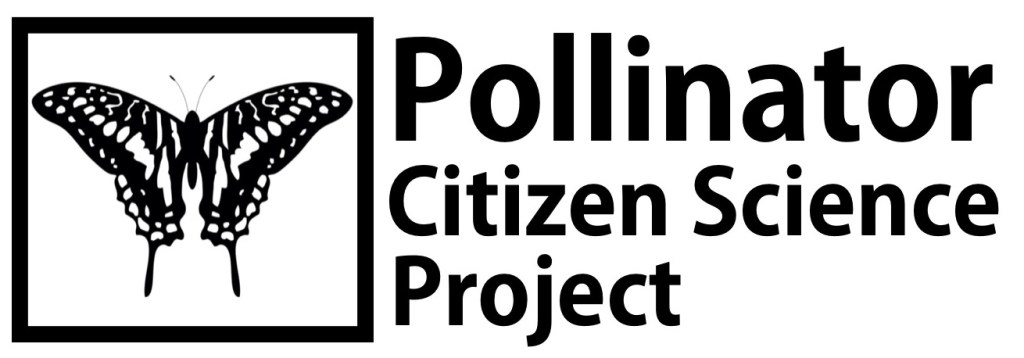 Master Volunteers, a group that includes Master Gardeners, contributed 7434 observations to the Pollinator Citizen Science Project according to the last updated summary on December 21, 2020. Based on data collected in the project so far, the most visited plant by honey bees was Melochia tomentosa, also known as Teabush or Pyramid Bush. For more information about this Texas native pollinator plant, visit the USDA Plant Database or the Lady Bird Johnson Wildlife Center website
Master Volunteers, a group that includes Master Gardeners, contributed 7434 observations to the Pollinator Citizen Science Project according to the last updated summary on December 21, 2020. Based on data collected in the project so far, the most visited plant by honey bees was Melochia tomentosa, also known as Teabush or Pyramid Bush. For more information about this Texas native pollinator plant, visit the USDA Plant Database or the Lady Bird Johnson Wildlife Center website
The purpose of the project is to use citizen scientists to determine the attractiveness of different commercially available ornamentals (annuals or perennials) to different groups of pollinators in the Southern USA, namely Texas and Oklahoma.
Due to popular demand and great results from 2020 and 2019, Pollinator Citizen Science Project is launching yet again this year. The required training and quiz start online on-demand Monday March 22, 2021, accessible through the project page. The training will be similar to last year, with some added training on plant identification (offered by Dr. Vikram Baliga from Texas Tech University). There will also be a live Q&A session later that week to answer any questions citizen scientists may have related to the project.
As before, BMGA members may recieve CEU credit for the training and volunteer hour credit for the time collecting and submitting data to the project. This is a true citizen science project allowing ordinary citizens to make a contribution that matters to the horticulture of our state.
When: Mar 25, 2021 02:30 PM Central Time (US and Canada)
https://agrilife.zoom.us/meeting/register/tJMqc-2rqzkvGdfxKLO8vgAuj9ulTtgO3FiL
Results for 2020
Result for 2019
Many congratulations to the Project Team:
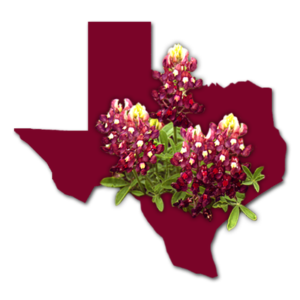 Sometimes, the answer is just knowing where to look; and someitimes, a picutre is just what you need to answer the question. With the help of many collaborators, Aggie Horticulture assembled a few theme-oriented searchable databases for use in their classes and for the public to use and enjoy. If you have not checked out Aggie Horticulture’s Plant Picturepages, the link is below. Find the information you need in pictures or just enjoy the many horticulature related sites and photos.
Sometimes, the answer is just knowing where to look; and someitimes, a picutre is just what you need to answer the question. With the help of many collaborators, Aggie Horticulture assembled a few theme-oriented searchable databases for use in their classes and for the public to use and enjoy. If you have not checked out Aggie Horticulture’s Plant Picturepages, the link is below. Find the information you need in pictures or just enjoy the many horticulature related sites and photos.
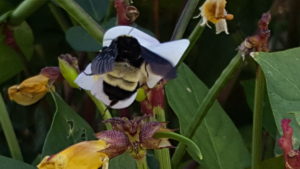 If you missed Wizzie Brown’s Backyard Bug Hunt webinars, below are links to recorded series to date.
If you missed Wizzie Brown’s Backyard Bug Hunt webinars, below are links to recorded series to date.
Ms. Brown is an Integrated Pest Management Program Specialist in Travis County. She earned a Bachelor of Science degree in Entomology from the The Ohio State University in 1996 and her Masters in Entomology at Texas A&M University in 1999.
When you find insects in your garden, your first instinct might be to destroy them, but that’s not always the best action. Of the 1.5 million known insect species in the world, more than 97% are beneficial to gardens, or simply benign. That leaves less than 3% that are agricultural and nuisance pests.
Bluebonnet Master Gardeners may claim CEU credit for these live or recorded events.
You may watch these webinars on the Travis County AgriLife Extension site or click the topics below:
Butterfly & caterpillar ID (Nymphalids & Papilionids)
Attracting insects to your yard
Fly identification & management
Mexican heather, an old-fashioned and reliable pollinator-friendly ornamental plant that adds big color to gardens and landscapes has been named the latest Texas Superstar. David Rodriguez, Texas A&M AgriLife Extension Service horticulturist, San Antonio, said Mexican heather has been a favorite ornamental plant in Texas gardens for many years. Mexican heather plants are also a top attractor for pollinators like bees and butterflies.
Mexican heather is best used in massing beddings, borders and containters. It also is excellent in butterfly and pollinator gardens and hanging baskets.
Allyson Mexican heather is one of the top performing varieties of this newly named Texas Superstar. (Photo by Brent Pemberton).
“There are other common selections of Mexican heather that are great plants, and I encourage gardeners to experiment with combinations, but we think Allyson is the best performing variety at this time,” he said. “It’s perfect for all sorts of plantings and works in all the criteria we look for in a Texas Superstar, including its role as an attractor of beneficial insects and pollinators.”
To be designated a Texas Superstar, a plant must be beautiful and perform well for growers throughout the state. Texas Superstars must also be easy to propagate, ensuring the plants are widely available and reasonably priced.
Texas Superstar® is a registered trademark owned by Texas A&M AgriLife Research, a state agency that is part of the Texas A&M University System. Plants are designated Texas Superstars by the Texas Superstar executive board, made up of nine horticulturalists from AgriLife Research, Texas A&M AgriLife Extension Service and Texas Tech University.
This post was summarized from and the photograph was taken from AgriLife TODAY. For more information about Mexican heather, see the full AgriLife Today article about Mexican heather.